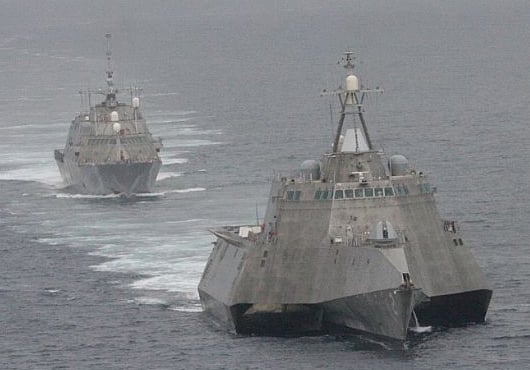Navy leadership responded Wednesday to a Tuesday Pentagon report saying both variants of the littoral combat ship (LCS) are “not survivable in a combat environment.”
Rear Adm. Tom Eccles, Deputy Commander for Naval System Engineering at Naval Sea Systems Command (NAVSEA) and Director Navy Staff, Vice Adm. Rick Hunt both defended the survivability of the ships during a Wednesday panel discussion on the LCS at the 2013 Surface Navy Association Symposium.

“Survivability issue is one that comes up quite a bit. The question: Are all ships survivable to the same level? Clearly they are not,” Hunt said.
“That’s where tradeoffs come in. Do you have smaller things or do you have single massive ships across the board? The scaling has been different throughout the history of navies and continues to be different today.”
On Tuesday the Office of the Secretary of Defense released its Fiscal Year 2012 report from the Director of Operational Test and Evaluation (DOT&E). The report concluded that the “LCS is not expected to be survivable in that it is not expected to maintain mission capability after taking a significant hit in a hostile combat environment.”
The Navy has three levels of survivability for the ships in the Fleet, according to an August 2012 report on the LCS from the Congressional Research Service that quotes Navy standards from 1988.
“The Navy decided to design the LCS to what it calls a Level 1+ survivability standard, which is greater than the Level I standard to which the Navy’s current patrol craft and mine warfare ships were designed, but less than the Level II standard to which the Navy’s current Oliver Hazard Perry (FFG-7)-class frigates were designed, ” the report says.
“Navy surface ships are designed to one of three survivability standards, called Level I (low), Level II (moderate), and Level III (high). Aircraft carriers, cruisers, and destroyers are designed to Level III. Frigates, amphibious ships, and certain underway replenishment (resupply) ships are designed to Level II. Other replenishment ships, as well as mine warfare ships, patrol craft, and support ships are designed to Level I.”
NAVSEA’s Eccles said the other factors in addition to how well a ship could absorb a direct hit were factors in the LCS survivability rating.
“Survivability comes in a lot of shapes and sizes. The ability to recover also includes the ability to reduce how susceptible one is to the presumed attack in the first place. Taking into consideration all the different dimensions of what defines survivability this ship meets its requirements and it does so with a combination of it’s technical capability, its speed, it’s ability to evade, and its ability to engage. It also does so with its ability to perform to a mission spec that is appropriate to the threat environment,” he said.
“Every ship type and class in our inventory has its own survivability spec and these ships are designed for speed and their ability to bring a modular capability to the fight and [they are]designed to be in the fight and get themselves out of that fight when required.”
Program Executive Officer for LCS, Rear Adm. James Murdoch, in response to the survivability question compared the LCS with the Level 1-survivable wooden Avenger-class minesweepers.
“It’ll be a lot nicer to be on a LCS than on a wooden ship,” he said.





